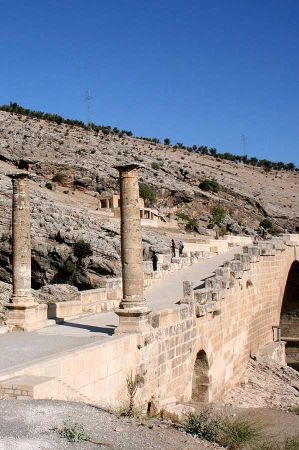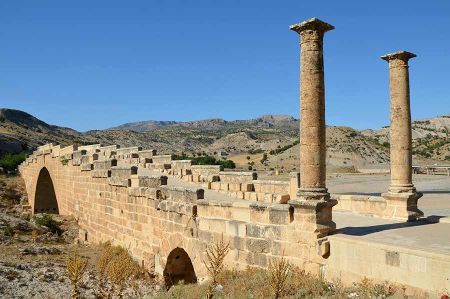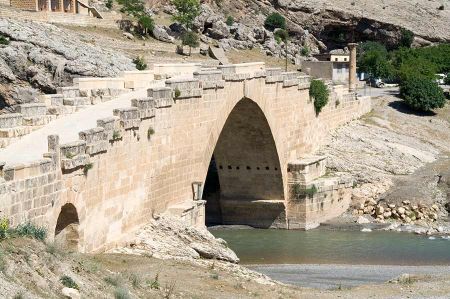Cendere Köprüsü - the bridge over the Chabinas
- Written by Portal Editor
In the southeast of Turkey, as part of our project, we followed the traces of the Roman road from Samosata towards Militene and came across the ancient Roman arched bridge over the Chabinas River near the town of Eski Kahta.
The river, now known as Cendere Cayi, crossed the then important marching and supply routes of the Romans in the power struggle against the Parthian ethnic groups living here, which is why it was decided to build the monumental wedge-shaped arched bridge.
By order of Emperor Septimius Severus (193 - 211 AD)
 According to one of the Latin building inscriptions on the bridge, there was already a bridge structure that was to be replaced "a soli" (from the ground up). On the orders of Emperor Septimius Severus (193 - 211 AD), the bridge was then rebuilt by the Legio XVI Flavia Company stationed in Samosata under the command of Lucius Marius Perpetuus. Since time was of the essence due to the extensive military operations, the stone material for building the bridge was taken from the nearby Commagene hierothesion on Karakuş and transported here.
According to one of the Latin building inscriptions on the bridge, there was already a bridge structure that was to be replaced "a soli" (from the ground up). On the orders of Emperor Septimius Severus (193 - 211 AD), the bridge was then rebuilt by the Legio XVI Flavia Company stationed in Samosata under the command of Lucius Marius Perpetuus. Since time was of the essence due to the extensive military operations, the stone material for building the bridge was taken from the nearby Commagene hierothesion on Karakuş and transported here.
With its clear width of an impressive 34.20 meters, the bridge, also named after Emperor Septimius Severus, is one of the largest arched bridges of all the surviving Roman bridges. The total length of 123 meters with a width of between 7.56 and 8.20 meters provides further evidence of the structural efficiency of Roman architecture, which was able to meet all requirements for 1,800 years. Three of the four columns that once stood on either side of the bridge entrance are still there.
Today the bridge is closed to all vehicle traffic
 The two columns on the southwest side bear honorary Latin inscriptions from the Emperor Septimius Severus and his wife Julia Domna. On the opposite side there is only the column with the inscription for Caracalla, son and later successor of Severus. The fourth column, which was previously assigned to his brother Geta, was probably removed in 212 after his "damnatio memoriae", which under the Romans means the cursing and ostentatious erasure of a person's memory by posterity. Geta and Caracalla, as sons of the dynasty's founder Septimius Severus, were made co-regents and prepared for joint succession. After their father's death, they succeeded him as regent together on February 4, 211, as planned. However, their joint rule failed that same year due to the deadly rivalry between the brothers. Caracalla lured Geta into a trap and had him murdered, thereby erasing all earthly memories of Geta.
The two columns on the southwest side bear honorary Latin inscriptions from the Emperor Septimius Severus and his wife Julia Domna. On the opposite side there is only the column with the inscription for Caracalla, son and later successor of Severus. The fourth column, which was previously assigned to his brother Geta, was probably removed in 212 after his "damnatio memoriae", which under the Romans means the cursing and ostentatious erasure of a person's memory by posterity. Geta and Caracalla, as sons of the dynasty's founder Septimius Severus, were made co-regents and prepared for joint succession. After their father's death, they succeeded him as regent together on February 4, 211, as planned. However, their joint rule failed that same year due to the deadly rivalry between the brothers. Caracalla lured Geta into a trap and had him murdered, thereby erasing all earthly memories of Geta.
 We are thrilled by the dimensions and complexity of the bridge construction, which first had to be renovated in 1998. After the reopening, only vehicle operation up to a maximum of 5 tons was permitted in order to permanently protect the structure. In the future, heavy goods traffic should be rerouted about 800 meters to the east over a new bridge. In conversation with others present, we learned that in 2005 a Turkish tanker driver, whose vehicle was fully loaded, did not adhere to the closure, whereupon the bridge completely collapsed when he tried to cross it. Pressure from the population and many people with an interest in preserving the cultural asset of the Roman arched bridge ensured that the stone blocks were cleaned and put back together. Of course, some of the wedge stone blocks also had to be replaced. Today the bridge is closed to all vehicle traffic.
We are thrilled by the dimensions and complexity of the bridge construction, which first had to be renovated in 1998. After the reopening, only vehicle operation up to a maximum of 5 tons was permitted in order to permanently protect the structure. In the future, heavy goods traffic should be rerouted about 800 meters to the east over a new bridge. In conversation with others present, we learned that in 2005 a Turkish tanker driver, whose vehicle was fully loaded, did not adhere to the closure, whereupon the bridge completely collapsed when he tried to cross it. Pressure from the population and many people with an interest in preserving the cultural asset of the Roman arched bridge ensured that the stone blocks were cleaned and put back together. Of course, some of the wedge stone blocks also had to be replaced. Today the bridge is closed to all vehicle traffic.
Coordinates: 37° 55′ 57.7″ N, 38° 36′ 30.6″ E
Please read as well:
The history of tolls or road user charges
Pasha - a "significant" title in the Ottoman Empire
https://www.alaturka.info/en/turkey-country/centralanatolia/6346-cendere-koepruesue-the-bridge-over-the-chabinas#sigProId2c89ef5013
